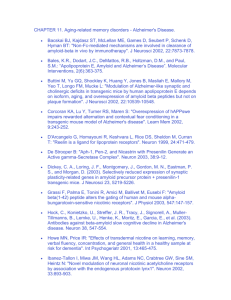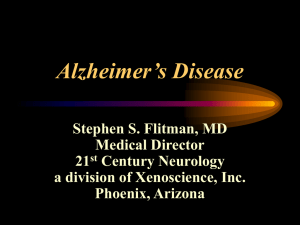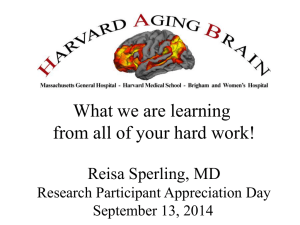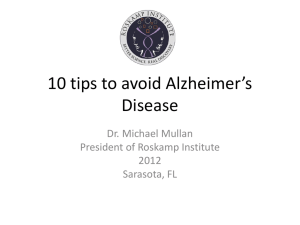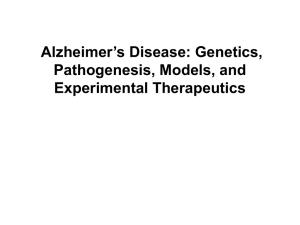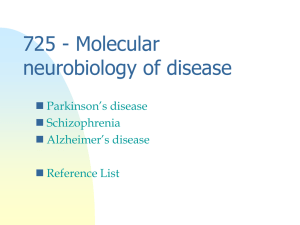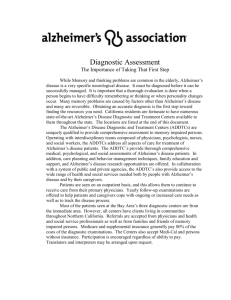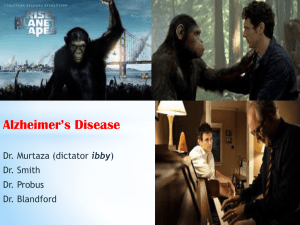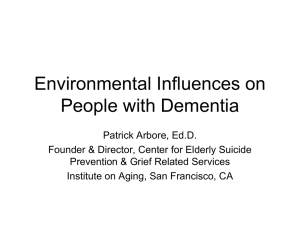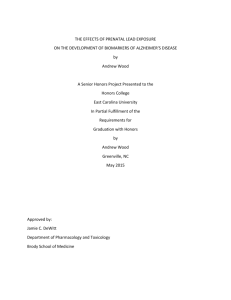microhemorrhage, alzheimer`s disease and the use of animal
advertisement
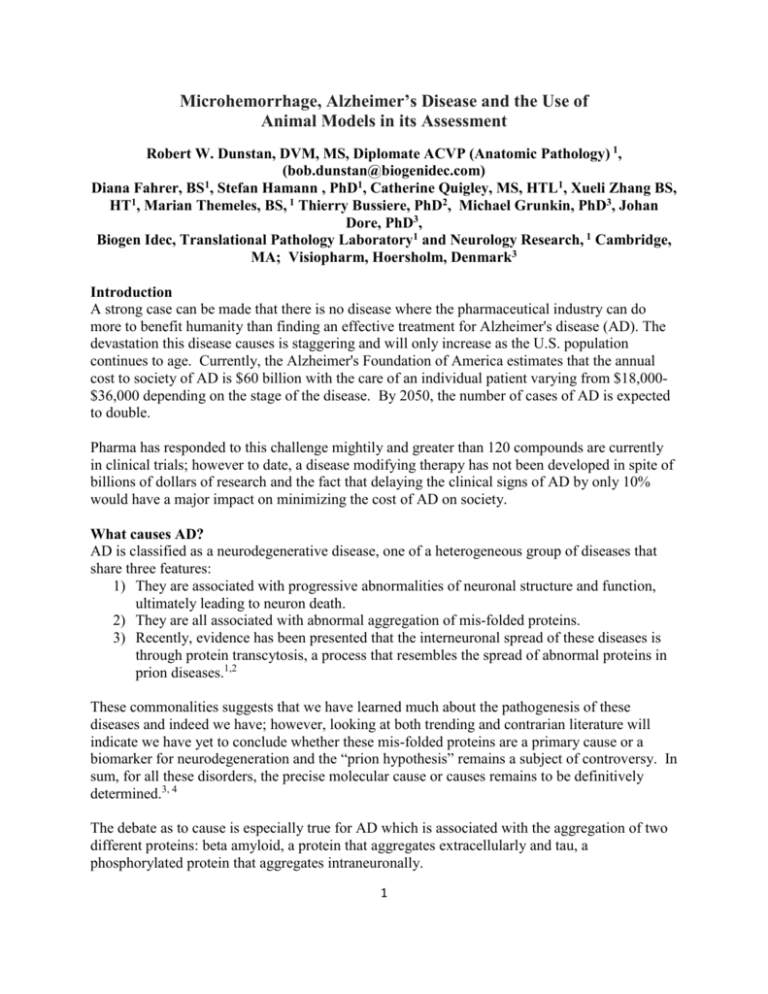
Microhemorrhage, Alzheimer’s Disease and the Use of Animal Models in its Assessment Robert W. Dunstan, DVM, MS, Diplomate ACVP (Anatomic Pathology) 1, (bob.dunstan@biogenidec.com) Diana Fahrer, BS1, Stefan Hamann , PhD1, Catherine Quigley, MS, HTL1, Xueli Zhang BS, HT1, Marian Themeles, BS, 1 Thierry Bussiere, PhD2, Michael Grunkin, PhD3, Johan Dore, PhD3, Biogen Idec, Translational Pathology Laboratory1 and Neurology Research, 1 Cambridge, MA; Visiopharm, Hoersholm, Denmark3 Introduction A strong case can be made that there is no disease where the pharmaceutical industry can do more to benefit humanity than finding an effective treatment for Alzheimer's disease (AD). The devastation this disease causes is staggering and will only increase as the U.S. population continues to age. Currently, the Alzheimer's Foundation of America estimates that the annual cost to society of AD is $60 billion with the care of an individual patient varying from $18,000$36,000 depending on the stage of the disease. By 2050, the number of cases of AD is expected to double. Pharma has responded to this challenge mightily and greater than 120 compounds are currently in clinical trials; however to date, a disease modifying therapy has not been developed in spite of billions of dollars of research and the fact that delaying the clinical signs of AD by only 10% would have a major impact on minimizing the cost of AD on society. What causes AD? AD is classified as a neurodegenerative disease, one of a heterogeneous group of diseases that share three features: 1) They are associated with progressive abnormalities of neuronal structure and function, ultimately leading to neuron death. 2) They are all associated with abnormal aggregation of mis-folded proteins. 3) Recently, evidence has been presented that the interneuronal spread of these diseases is through protein transcytosis, a process that resembles the spread of abnormal proteins in prion diseases.1,2 These commonalities suggests that we have learned much about the pathogenesis of these diseases and indeed we have; however, looking at both trending and contrarian literature will indicate we have yet to conclude whether these mis-folded proteins are a primary cause or a biomarker for neurodegeneration and the “prion hypothesis” remains a subject of controversy. In sum, for all these disorders, the precise molecular cause or causes remains to be definitively determined.3, 4 The debate as to cause is especially true for AD which is associated with the aggregation of two different proteins: beta amyloid, a protein that aggregates extracellularly and tau, a phosphorylated protein that aggregates intraneuronally. 1 The aggregation of beta amyloid starts with a trans-cellular protein, amyloid precursor protein whose function remains enigmatic. 4 Normally this protein is cleaved by the enzyme, alpha secretase and the protein is degraded; however, when it is differentially cleaved by the enzyme beta secretase the remnant peptide can accumulate first as monomers, then as oligomers (generally believed to be the most toxic form of beta-amyloid) and eventually into large extracellular aggregates in the neuropil (where they are called plaques) or within vessels. The presence of large amounts of amyloid typically although not invariably is associated with neurodegeneration and cognitive dysfunction. This is the basis for the amyloid cascade hypothesis, the dominant theory for the cause of AD.1 Tau is a phosphoprotein that promotes the assembly and stabilization of tubulin into microtubules. In the normal adult human brain there are 2 to 3 moles of phosphate per mole of tau protein. In AD brains, tau is 3 to 4 times more hyperphosphorylated. This hyper phosphorylation is thought to depress the biological activity of tau and allows for its polymerization into paired helical filaments admixed with straight filaments. In combination, the polymerized tau molecules form intra-neuronal fibrillary tangles which are the histologic hallmark of the tauopathies, including AD. As there are proponents of the amyloid cascade pathologist, there are also “Taoists” who maintain that intraneuronal tau aggregates are the major player in the development of AD. Developing therapeutic strategies: Perhaps because there is no clear consensus as to the cause of AD, a diverse array of compounds that intercede in multiple biochemical pathways believed to be important in the development of this disease are currently being developed to treat AD. Those currently approved are largely cholinergic drugs that are aimed more at preserving function then correcting the disease. Therapeutic strategies aimed at actually modifying the disease can largely be classified as having one or more functions involved in decreasing beta-amyloid production, decreasing beta-amyloid aggregation, increasing beta amyloid clearance and decreasing tau aggregation and/or phosphorylation. To date, none have been shown to be effective to the point where they can be used as an approved treatment, What we have learned by our lack of success is that it is unlikely that pharmacologic intervention will substantively decrease existing beta amyloid aggregates and clinical trials are now starting during the prodromal phases of the disease before substantive accumulations are deposited. 7-10 What cannot be over emphasized is the expense of these clinical trials. The earlier in the development of the disease trials begin, the longer the period of time needs to occur before the treatment group can be statistically separated from the placebo control group or better methods need to be developed to recognize subtle changes in brain structure and function that will enable detection of early beneficial therapeutic effects. To this end, considerable emphasis has been placed on in vivo imaging to define whether plaques are diminishing, blood flow is increasing and toxic effects of therapy are not occurring. All clinical trials now include in vivo imaging at multiple time points using multiple imaging modalities to get a clear picture of disease progression/regression/toxicity.11,12 2 Animal models of Alzheimer’s disease Although drug companies recognize the impact of an effective treatment for AD, they also recognize the cost of a clinical trial which may now be well in the billions of dollars. As a result, there is a need to accurately assess drug efficacy and safety before ever going into humans. Currently, animal models represent the most widely used system for this purpose. Three types of models are currently available: 1) Spontaneous models of AD: Humans are not the only mammals to develop AD. For example, both nonhuman primates and dogs can develop parenchymal and vascular betaamyloid deposits and non-human primates have also been identified with neurofibrillary tangles with paired helical filaments similar to the tau aggregates seen in humans with AD. However, animal care and use consideration, the fact that spontaneous models can take a long time to develop and the sporadic nature of these lesions have precluded them from serious consideration in AD investigations.13-15 2) Transgenic mouse models of AD: Transgenic mice are the most commonly used models to define drug efficacy and safety for anti-amyloid and anti-tau therapies. A large number of models are available that are associated with the deposit of beta amyloid, tau and in more sophisticated transgenic models, both beta-amyloid and tau. Readers are referred to cited references for more complete listings (below). What needs to be recognized is that all drugs developed to treat AD that failed clinical trials were shown to be effective in transgenic mouse models. In addition, little attention has been paid to the type of transgenic mouse used in pre-clinical efficacy studies making it hard to perform valid inter-study comparisons because of lesion heterogeneity among these different mice. Finally, there is no standardized method for evaluating efficacy or toxicity in these models. In short, transgenic mice have become an essential component of preclinical testing however it is widely believed they are at best only moderately predictive of the human disease. In addition, these models are expensive and may take a long time to develop sufficiently abundant lesions where they can be used in preclinical trials.9,16-19 3) Vector-induced models: an emerging alternative to transgenic mice is the use of adeno associated viral vectors to induce neurodegenerative diseases. Derived from non-pathogenic parvoviruses, these viruses allow for robust expression of transgenes in-vivo. AAV vectors can be designed to target neurons exclusively in the brain. They can also be tagged with fluorescent reporter molecules making it easy to recognize where gene expression is occurring. As a rule, AAV gene delivery results in the development of lesions more rapidly than genetically modified mice and induction is not species specific. A non-transgenic mouse is usually used for induction so the cost of animals is much less. Lastly, because the AAV vectors can be injected into a defined region of the brain, they can be used to study transcellular spread of lesions. For these reasons, AAV models are being used more and more to study neurodegeneration.20,21 The role of veterinary pathology in the development of effective therapies for AD Veterinary pathology should play an essential role in drug development for AD; however, maximizing impact will probably require more rigorous evaluation of the morphologic changes 3 associated with AD than has been the traditional role for anatomic veterinary pathology. For example, visual inspection and binned classification simply do not offer the differential quality needed to discern the subtle differences. To accomplish this, standard visual evaluations will be replaced by computer quantification on digital images. There are three highly impactful areas where veterinary pathology should provide leadership: 1) Establishing standardized methods for study design and the evaluation of efficacy studies 2) Establishing standardized methods for defining FDA required safety endpoints 3) Qualifying in vivo imaging methods Establishing standardized methods for study design and the evaluation of efficacy studies: A major problem with developing effective therapies for AD is that animal biomedical experiments have failed to translate well into human clinical trials. Although this failure is generally assumed to be due to the inherent biological differences between humans and animals, a recent article by Tsilidis et al., makes a strong case that selective analyses and outcome reporting biases play a major role in demonstrating a false treatment effect in preclinical studies, in particular those used to define neurologic disease. Although in all probability both poor translatability of animal models and evaluation biases play a role in this lack of predictability of animal studies, unless one avoids the study biases, one can never improve upon the animal models being studied .22 For this reason, there need to standardize methods to quantify a treatment effect in animal experiments for AD and this has not been done. Reports of therapeutic efficacy in animal studies on transgenic mice have simply no consistency. Not only is there variability in the transgenic mouse model used but also in the age and gender of the animal, the duration of the study, the number of animals used, the method of fixation and processing, section thickness and number of sections evaluated, staining used to define beta-amyloid and/or tau, method of quantification and method of statistical analysis. Without this standardization it is simply impossible to avoid study biases or to learn from the experience of others.23-25 Establishing standardized methods for defining FDA required safety endpoints: In 2012, it was reported in a phase 2 clinical trial for an antibody-based therapy to reduce beta amyloid that localized edema and microhemorrhage were being detected on MRI scans. In response to this finding, FDA sent a letter to all pharmaceutical companies involved in developing therapies to treat Alzheimer’s requesting “all patients must have an MRI scan of the brain at screening or baseline” and at three months intervals during the course of the trial. At the same time, it was requested that “development of programs for compounds expected to reduce beta amyloid in the brain by any mechanism should include a nonclinical study investigating the potential induction of cerebral microhemorrhage.” 26 Although standard toxicopathology examination needs to be performed on all animals, a critical component to this evaluation needs is to define whether microhemorrhage is increased. As with defining efficacy endpoints, it is important that veterinary pathologists work together to establish consistent and reproducible methods to define microhemorrhage. Once again, the literature demonstrates no consistency in how microhemorrhage is evaluated. 4 A critical question that should be advanced is whether the presence or absence of microhemorrhage in mice is translatable to humans. 27,28 Qualifying in vivo imaging methods: As clinical trials for AD therapies are now anticipated to begin during prodromal stages of the disease, the use of in vivo imaging to establish morphologic biomarkers of efficacy is essential for defining early therapeutic effects. To this end, it is not important whether an imaging agent or modality can identify beta amyloid or tau, what is important is whether these methods can define changes in their expression that may represent only a 5% reduction. For AD, this will require rigorous correlation of in vivo images with histopathology. Considering that brain biopsies in humans are not an option and obtaining brain sections from deceased patients that were taken at the time of the in vivo image is also extremely difficult to obtain, this correlation can best be done using animal models. Fortunately, animal models make an ideal surrogate for humans being smaller and with most imaging agents and methods are totally translatable to humans. Ideally the histopathology should be performed to allow for 3-D reconstruction.29,30 Conclusions With the exception of cancer, finding effective and safe treatments for AD remains the highest therapeutic priority for the pharmaceutical industry. To date, identification of a disease modifying therapy has been much more elusive than was anticipated; however, we continue to expand our knowledge base through collaborative efforts among biochemists, neurologists, neuropathologists, veterinary pathologists and of course, the patients suffering from this dreaded disease. Because of the reliance of animal models to predict those compounds that should enter into clinical trials, it is essential that veterinary pathologist play a major role in this process. References 1. Roberson, Erik D., and Lennart Mucke. "100 years and counting: prospects for defeating Alzheimer's disease." Science 314.5800 (2006): 781-784. 2. Jucker, Mathias, and Lary C. Walker. "Pathogenic protein seeding in Alzheimer disease and other neurodegenerative disorders." Annals of neurology 70.4 (2011): 532-540. 3. Karran, Eric, Marc Mercken, and Bart De Strooper. "The amyloid cascade hypothesis for Alzheimer's disease: an appraisal for the development of therapeutics." Nature Reviews Drug Discovery 10.9 (2011): 698-712. 4. Ittner, Lars M., and Jürgen Götz. "Amyloid-β and tau—a toxic pas de deux in Alzheimer's disease." Nature Reviews Neuroscience 12.2 (2010): 67-72. 5. Nalivaeva, Natalia N., and Anthony J. Turner. "The amyloid precursor protein: A biochemical enigma in brain development, function and disease." FEBS letters (2013). 6. Iqbal, Khalid, et al. "Tau in Alzheimer disease and related tauopathies." Current Alzheimer Research 7.8 (2010): 656. 7. Mangialasche, Francesca, et al. "Alzheimer's disease: clinical trials and drug development." The Lancet Neurology 9.7 (2010): 702-716. 8. Panza, Francesco, et al. "Immunotherapy for Alzheimer's disease: from anti-β-amyloid to tau-based immunization strategies." Immunotherapy 4.2 (2012): 213-238. 5 9. Li, Chaoyun, Azadeh Ebrahimi, and Hermann Schluesener. "Drug pipeline in neurodegeneration based on transgenic mice models of Alzheimer's disease." Ageing research reviews (2012). 10. http://www.nia.nih.gov/alzheimers/clinical-trials 11. Frisoni, Giovanni B., et al. "Imaging markers for Alzheimer disease Which vs how." Neurology 81.5 (2013): 487-500. 12. Davatzikos, Christos, et al. "Prediction of MCI to AD conversion, via MRI, CSF biomarkers, and pattern classification." Neurobiology of aging 32.12 (2011): 2322-e19. 13. Head, Elizabeth. "A Canine Model of Human Aging and Alzheimer’s Disease." Biochimica et Biophysica Acta (BBA)-Molecular Basis of Disease (2013). 14. Toledano, A., et al. "Does Alzheimer's disease exist in all primates? Alzheimer pathology in non-human primates and its pathophysiological implications (I)." Neurología (English Edition) 27.6 (2012): 354-369. 15. Delacourte, Andre. "Tauopathies: recent insights into old diseases." Folia Neuropathologica 43.4 (2005): 244. 16. Lee, Jung-Eun, and Pyung-Lim Han. "An Update of Animal Models of Alzheimer Disease with a Reevaluation of Plaque Depositions." Experimental neurobiology 22.2 (2013): 84-95. 17. Noble, W., D. P. Hanger, and J-M. Gallo. "Transgenic mouse models of tauopathy in drug discovery." CNS & Neurological Disorders-Drug Targets (Formerly Current Drug Targets-CNS & Neurological Disorders) 9.4 (2010): 403-428. 18. Koechling, Thorsten, et al. "Neuronal Models for Studying Tau Pathology." International journal of Alzheimer's disease 2010 (2010). 19. Zahs, Kathleen R., and Karen H. Ashe. "‘Too much good news’–are Alzheimer mouse models trying to tell us how to prevent, not cure, Alzheimer's disease?" Trends in neurosciences 33.8 (2010): 381-389. 20. Morgenstern, Peter F., et al. "Adeno-associated viral gene delivery in neurodegenerative disease." Neurodegeneration. Humana Press, 2011. 443-455. 21. Platt, Thomas L., Valerie L. Reeves, and M. Paul Murphy. "Transgenic Models of Alzheimer’s Disease: Better Utilization of Existing Models through Viral Transgenesis." Biochimica et Biophysica Acta (BBA)-Molecular Basis of Disease (2013). 22. Tsilidis, Konstantinos K., et al. "Evaluation of Excess Significance Bias in Animal Studies of Neurological Diseases." PLoS biology 11.7 (2013): e1001609. 23. Perez, Sylvia E., et al. "DHA diet reduces AD pathology in young APPswe/PS1ΔE9 transgenic mice: possible gender effects." Journal of neuroscience research 88.5 (2010): 1026-1040. 24. Kim, Tae-Kyung, et al. "Expression of the plant viral protease NIa in the brain of a mouse model of Alzheimer's disease mitigates Aβ pathology and improves cognitive function." Experimental & molecular medicine 44.12 (2012): 740-748. 25. Teipel, Stefan J., et al. "Automated Detection of Amyloid-β-Related Cortical and Subcortical Signal Changes ina Transgenic Model of Alzheimer's Disease using HighField MRI." Journal of Alzheimer's Disease 23.2 (2011): 221-237. 26. Sperling, Reisa, et al. "Amyloid-related imaging abnormalities in patients with Alzheimer's disease treated with bapineuzumab: a retrospective analysis." The Lancet Neurology 11.3 (2012): 241-249. 6 27. Zago, Wagner, et al. "Microvascular changes associated with passive immunotherapy in PDAPP mice: Potential implication for the etiology of vasogenic edema." Alzheimer's and Dementia 7.4 (2011): S531. 28. B Freeman, Gary, et al. "Chronic Administration of an Aglycosylated Murine Antibody of Ponezumab Does Not Worsen Microhemorrhages in Aged Tg2576 Mice." Current Alzheimer Research 9.9 (2012): 1059-1068. 29. Cuingnet, Rémi, et al. "Automatic classification of patients with Alzheimer's disease from structural MRI: a comparison of ten methods using the ADNI database." Neuroimage 56.2 (2011): 766-781. 30. Meadowcroft, Mark D., et al. "MRI and histological analysis of beta‐amyloid plaques in both human Alzheimer's disease and APP/PS1 transgenic mice." Journal of Magnetic Resonance Imaging 29.5 (2009): 997-1007. 7
